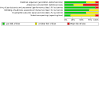Interventions for preventing and reducing the use of physical restraints for older people in all long-term care settings
- PMID: 37500094
- PMCID: PMC10374410
- DOI: 10.1002/14651858.CD007546.pub3
Interventions for preventing and reducing the use of physical restraints for older people in all long-term care settings
Abstract
Background: Physical restraints (PR), such as bedrails and belts in chairs or beds, are commonly used for older people receiving long-term care, despite clear evidence for the lack of effectiveness and safety, and widespread recommendations that their use should be avoided. This systematic review of the efficacy and safety of interventions to prevent and reduce the use of physical restraints outside hospital settings, i.e. in care homes and the community, updates our previous review published in 2011.
Objectives: To evaluate the effects of interventions to prevent and reduce the use of physical restraints for older people who require long-term care (either at home or in residential care facilities) SEARCH METHODS: We searched ALOIS, the Cochrane Dementia and Cognitive Improvement Group's register, MEDLINE (Ovid Sp), Embase (Ovid SP), PsycINFO (Ovid SP), CINAHL (EBSCOhost), Web of Science Core Collection (ISI Web of Science), LILACS (BIREME), ClinicalTrials.gov and the World Health Organization's meta-register, the International Clinical Trials Registry Portal, on 3 August 2022.
Selection criteria: We included randomised controlled trials (RCTs) and controlled clinical trials (CCTs) that investigated the effects of interventions intended to prevent or reduce the use of physical restraints in older people who require long-term care. Studies conducted in residential care institutions or in the community, including patients' homes, were eligible for inclusion. We assigned all included interventions to categories based on their mechanisms and components.
Data collection and analysis: Two review authors independently selected the publications for inclusion, extracted study data, and assessed the risk of bias of all included studies. Primary outcomes were the number or proportion of people with at least one physical restraint, and serious adverse events related to PR use, such as death or serious injuries. We performed meta-analyses if necessary data were available. If meta-analyses were not feasible, we reported results narratively. We used GRADE methods to describe the certainty of the evidence.
Main results: We identified six new studies and included 11 studies with 19,003 participants in this review update. All studies were conducted in long-term residential care facilities. Ten studies were RCTs and one study a CCT. All studies included people with dementia. The mean age of the participants was approximately 85 years. Four studies investigated organisational interventions aiming to implement a least-restraint policy; six studies investigated simple educational interventions; and one study tested an intervention that provided staff with information about residents' fall risk. The control groups received usual care only in most studies although, in two studies, additional information materials about physical restraint reduction were provided. We judged the risk of selection bias to be high or unclear in eight studies. Risk of reporting bias was high in one study and unclear in eight studies. The organisational interventions intended to promote a least-restraint policy included a variety of components, such as education of staff, training of 'champions' of low-restraint practice, and components which aimed to facilitate a change in institutional policies and culture of care. We found moderate-certainty evidence that organisational interventions aimed at implementation of a least-restraint policy probably lead to a reduction in the number of residents with at least one use of PR (RR 0.86, 95% CI 0.78 to 0.94; 3849 participants, 4 studies) and a large reduction in the number of residents with at least one use of a belt for restraint (RR 0.54, 95% CI 0.40 to 0.73; 2711 participants, 3 studies). No adverse events occurred in the one study which reported this outcome. There was evidence from one study that organisational interventions probably reduce the duration of physical restraint use. We found that the interventions may have little or no effect on the number of falls or fall-related injuries (low-certainty evidence) and probably have little or no effect on the number of prescribed psychotropic medications (moderate-certainty evidence). One study found that organisational interventions result in little or no difference in quality of life (high-certainty evidence) and another study found that they may make little or no difference to agitation (low-certainty evidence). The simple educational interventions were intended to increase knowledge and change staff attitudes towards PR. As well as providing education, some interventions included further components to support change, such as ward-based guidance. We found pronounced between-group baseline imbalances in PR prevalence in some of the studies, which might have occurred because of the small number of clusters in the intervention and control groups. One study did not assess bedrails, which is the most commonly used method of restraint in nursing homes. Regarding the number of residents with at least one restraint, the results were inconsistent. We found very-low certainty evidence and we are uncertain about the effects of simple educational interventions on the number of residents with PR. None of the studies assessed or reported any serious adverse events. We found moderate-certainty evidence that simple educational interventions probably result in little or no difference in restraint intensity and may have little or no effect on falls, fall-related injuries, or agitation (low-certainty evidence each). Based on very low-certainty evidence we are uncertain about the effects of simple educational interventions on the number of participants with a prescription of at least one psychotropic medication. One study investigated an intervention that provided information about residents' fall risk to the nursing staff. We found low-certainty evidence that providing information about residents' fall risk may result in little or no difference in the mean number of PR or the number of falls. The study did not assess overall adverse events.
Authors' conclusions: Organisational interventions aimed to implement a least-restraint policy probably reduce the number of residents with at least one PR and probably largely reduce the number of residents with at least one belt. We are uncertain whether simple educational interventions reduce the use of physical restraints, and interventions providing information about residents' fall risk may result in little to no difference in the use of physical restraints. These results apply to long-term care institutions; we found no studies from community settings.
Copyright © 2023 The Cochrane Collaboration. Published by John Wiley & Sons, Ltd.
Conflict of interest statement
Some authors (RM, SK, and GM) were involved in trials that were included in this review. All trials were funded by national grant agencies. No review author was involved in the data extraction of any trials in which they were or are involved.
Ralph Möhler: none known
Tabja Richter: none known
Sascha Köpke: none known
Gabriele Meyer: none known
Figures





















Update of
-
Interventions for preventing and reducing the use of physical restraints in long-term geriatric care.Cochrane Database Syst Rev. 2011 Feb 16;2011(2):CD007546. doi: 10.1002/14651858.CD007546.pub2. Cochrane Database Syst Rev. 2011. Update in: Cochrane Database Syst Rev. 2023 Jul 28;7:CD007546. doi: 10.1002/14651858.CD007546.pub3. PMID: 21328295 Free PMC article. Updated.
References
References to studies included in this review
Abraham 2019 {published data only}
-
- Abraham J, Bake M, Berger-Höger B, Köpke S, Kupfer R, et al. Process evaluation of a multicomponent intervention to prevent physical restraints in nursing homes (IMPRINT): A mixed methods study. Journal of Advanced Nursing 2021;77(3):1465-77. - PubMed
-
- Abraham J, Kupfer R, Behncke A, Berger-Höger B, Icks A, Haastert B, et al. Implementation of a multicomponent intervention to prevent physical restraints in nursing homes (IMPRINT): A pragmatic cluster randomized controlled trial. International Journal of Nursing Studies 2019;96:27-34. - PubMed
-
- NCT02341898. Implementation of a multicomponent intervention to prevent physical restraints in nursing home residents (IMPRINT). https://www.clinicaltrials.gov/ct2/show/NCT02341898 (first received 19 January 2015). - PMC - PubMed
-
- Nordhausen T, Abraham J, Kupfer R, Köpke S, Meyer G, Möhler R. Physical restraints from the perspective of advocates of nursing home residents - a qualitative Study [Freiheitseinschränkung aus Sicht der Interessenvertretungen von Pflegeheimbewohnerinnen und -bewohnern − eine qualitative Studie]. Pflege 2019;32(2):147-56. - PubMed
Dever Fitzgerald 2016 {published and unpublished data}
-
- Denver Fitzgerald TG, Hadjistavropoulos T, MacNab YC. Caregiver fear of falling and functional ability among seniors residing in long-term care facilities. Gerontology 2009;55(4):460-7. - PubMed
-
- Dever Fitzgerald T, Hadjistavropoulos T, Williams J, Lix L, Zahir S, Alfano D, Scudds R. The impact of fall risk assessment on nurse fears, patient falls, and functional ability in long-term care. Disability and Rehabilitation 2016;38(11):1041-52. - PubMed
Evans 1997 {published and unpublished data}
-
- Evans LK, Strumpf NE, Allen-Taylor SL, Capezuti E, Maislin G, Jacobsen B. A clinical trial to reduce restraints in nursing homes. Journal of the American Geriatrics Society 1997;45(6):675-81. - PubMed
-
- Siegler EL, Capezuti E, Maislin G, Baumgarten M, Evans L, Strumpf N. Effects of a restraint reduction intervention and OBRA '87 regulations on psychoactive drug use in nursing homes. Journal of the American Geriatrics Society 1997;45(7):791-6. - PubMed
Gulpers 2011 {published data only}
-
- Bleijlevens MH, Gulpers MJ, Capezuti E, Rossum E, Hamers JP. Process evaluation of a multicomponent intervention program (EXBELT) to reduce belt restraints in nursing homes. Journal of the American Medical Directors Association 2013;14(8):599-604. - PubMed
-
- Gulpers MJ, Bleijlevens MH, Ambergen T, Capezuti E, Rossum E, Hamers JP. Belt restraint reduction in nursing homes: effects of a multicomponent intervention program. Journal of the American Geriatrics Society 2011;59(11):2029-36. - PubMed
-
- Gulpers MJ, Bleijlevens MH, Ambergen T, Capezuti E, Rossum E, Hamers JP. Reduction of belt restraint use: long-term effects of the EXBELT intervention. Journal of the American Geriatrics Society 2013;61(1):107-12. - PubMed
-
- Gulpers MJ, Bleijlevens MH, Capezuti E, Rossum E, Ambergen T, Hamers JP. Preventing belt restraint use in newly admitted residents in nursing homes: a quasi-experimental study. International Journal of Nursing Studies 2012;49(12):1473-9. - PubMed
Huizing 2009 {published and unpublished data}
-
- Huizing A, Hamers J, Gulpers M, Berger M. A cluster-randomized trial of an educational intervention to reduce the use of physical restraints with psychogeriatric nursing home residents. Journal of the American Geriatrics Society 2009;57(7):1138-48. - PubMed
-
- Huizing A, Hamers J, Gulpers M, Berger M. Preventing the use of physical restraints on residents newly admitted to psycho-geriatric nursing home wards. International Journal of Nursing Studies 2009;46(4):459-69. - PubMed
Koczy 2011 {published data only}
-
- Koczy P, Becker C, Rapp K, Klie T, Beische D, Büchele G, Kleiner A, Guerra V, Rissmann U, Kurrle S, Bredthauer D. Effectiveness of a Multifactorial Intervention to Reduce Physical Restraints in Nursing Homes Residents. Journal of the American Geriatrics Society 2011;59(2):333-9. - PubMed
-
- Koczy P, Klie T, Kron M, Bredthauer D, Rissmann U, Branitzki S, Guerra V, Klein A, Pfundstein T, Nikolaus T, Sander S, Becker C. Effectiveness of a multifactorial intervention to reduce physical restraints in nursing home residents with dementia [Effektivität einer multifaktoriellen Intervention zur Reduktion von körpernaher Fixierung bei demenzerkrankten Heimbewohnern]. Zeitschrift für Gerontologie und Geriatrie 2005;38(1):33-9. - PubMed
Köpke 2012 {published data only}
-
- Gerlach A, Köpke S, Haut A, Meyer G. Process evaluation of the implementation of a guideline-based complex Intervention in nursing homes [Prozessevaluation der Implementierung einer Leitlinien-gestützten komplexen Intervention in Alten- und Pflegeheim]. In: 13th Annual Meeting of the German Network for Evidence-Based Medicine March 15th- 17th, Hamburg. 2012.
-
- Köpke S, Mühlhauser I, Gerlach A, Haut A, Haastert B, Möhler R, Meyer G. Effect of a guideline-based multicomponent intervention on use of physical restraints in nursing homes: a randomized controlled trial. Journal of the American Medical Association 2012;307(20):2177-84. - PubMed
Pellfolk 2010 {published data only}
-
- ISRCTN36604462. Effects of a restraint minimization educational programme on physical restraints use, staff knowledge, attitudes, and perceived job strain. https://www.isrctn.com/ISRCTN36604462 (first received 18 April 2008).
-
- Pellfolk T, Gustafson Y, Bucht G, Karlsson S. Effects of a Restraint Minimization Program on Staff Knowledge, Attitudes, and Practice: A Cluster Randomized Trial. Journal of the American Geriatrics Society 2010;58:62-9. - PubMed
Testad 2005 {published and unpublished data}
-
- Testad I, Aasland A, Aarsland D. The effect of staff training on the use of restraint in dementia: a single-blind randomised controlled trial. International Journal of Geriatric Psychiatry 2005;20:587-90. - PubMed
Testad 2010 {published and unpublished data}
-
- Testad I, Ballard C, Brønnick K, Aarsland D. The effect of staff training on agitation and use of restraint in nursing home residents with dementia: a single-blind, randomized controlled trial. Journal of Clinical Psychiatry 2010;71(1):80-6. - PubMed
Testad 2016 {published data only}
-
- Mekki TE, Øye C, Kristensen B, Dahl H, Haaland A, Nordin KA, et al. The inter-play between facilitation and context in the promoting action on research implementation in health services framework: A qualitative exploratory implementation study embedded in a cluster randomized controlled trial to reduce restraint in nursing homes.. 2017 Journal of Advanced Nursing;73(11):2622-32. - PubMed
-
- NCT01715506. Continuing education in nursing home dementia care (MEDCED). https://clinicaltrials.gov/ct2/show/NCT01715506 (first received 29 October 2012).
-
- Testad I, Mekki TE, Førland O, Øye C, Tveit EM, Jacobsen F, Kirkevold Ø. Modeling and evaluating evidence-based continuing education program in nursing home dementia care (MEDCED)--training of care home staff to reduce use of restraint in care home residents with dementia. A cluster randomized controlled trial. International Journal of Geriatric Psychiatry 2016;31(1):24-32. - PubMed
References to studies excluded from this review
Branitzki 2005 {published data only}
-
- Branitzki S, Koczy P. [ReduFix- a study of reducing physical restraint: preventing risk of injury]. Pflege Zeitschrift 2005;58(5):310-3. - PubMed
Capezuti 1998 {published data only}
-
- Capezuti E, Strumpf NE, Evans LK, Grisso JA, Maislin G. The relationship between physical restraint removal and falls and injuries among nursing home residents. Journals of Gerontology. Series A, Biological Sciences and Medical Sciences 1998;53(1):M47-52. - PubMed
Capezuti 2007 {published data only}
-
- Capezuti E, Wagner L, Brush B, Boltz M, Renz S, Talerico K. Consequences of an intervention to reduce restrictive side rail use in nursing homes. Journal of the American Geriatrics Society 2007;55:334-41. - PubMed
Chan 2022 {published data only}
-
- Chan HY, Ho FK, Chui KC, Wong BP, Chui MY, Zhao Y, et al. Evaluation of a multicomponent restraint reduction intervention in care homes. Collegian 2022 July 6 [Epub ahead of print]. [DOI: 10.1016/j.colegn.2022.06.009] - DOI
Chang 2016 {published data only}
-
- Chang YY, Yu HH, Loh el-W, Chang LY. The Efficacy of an In-Service Education Program Designed to Enhance the Effectiveness of Physical Restraints. Journal of Nursing Research 2016;24(1):79-86. - PubMed
Choi 2009 {published data only}
-
- Choi K, Kim J. Effects of an educational program for the reduction of physical restraint use by caregivers in geriatric hospitals. Journal of Korean Academy of Nursing 2009;39(6):769-80. - PubMed
Dewey 2000 {published data only}
-
- Dewey K, Brill C. Decrease in restraint use in a study of a geropsychiatric unit. Journal of Psychosocial Nursing and Mental Health Services 2000;38(10):14-8, 44-5. - PubMed
Ejaz 1994 {published data only}
-
- Ejaz FK, Jones JA, Rose MS. Falls among nursing home residents: an examination of incident reports before and after restraint reduction programs. Journal of the American Geriatrics Society 1994;42(9):960-4. - PubMed
Enns 2014 {published data only}
-
- Enns E, Rhemtulla R, Ewa V, Fruetel K, Holroyd-Leduc JM. A controlled quality improvement trial to reduce the use of physical restraints in older hospitalized adults. Journal of the American Geriatrics Society 2014;62(3):541-5. - PubMed
Evans 2002 {published data only}
-
- Evans D, Wood J, Lambert L. A review of physical restraint minimization in the acute and residential care settings. Journal of Advanced Nursing 2002;40:616-25. - PubMed
Frank 1996 {published data only}
Healey 2008 {published data only}
-
- Healey F, Oliver D, Milne A, Connelly J. The effect of bedrails on falls and injury: a systematic review of clinical studies. Age and Ageing 2008;37:368-78. - PubMed
Kong 2017 {published data only}
-
- Kong EH, Song E, Evans LK. Effects of a Multicomponent Restraint Reduction Program for Korean Nursing Home Staff. Journal of Nursing Scholarship 2017;49(3):325-35. - PubMed
Kotynia‐English 2005 {published data only}
-
- Kotynia-English R, McGowan H, Almeida OP. A randomized trial of early psychiatric intervention in residential care: impact on health outcomes. International Psychogeriatrics 2005;17(3):475-85. - PubMed
Levine 1995 {published data only}
-
- Levine JM, Marchello V, Totolos E. Progress toward a restraint-free environment in a large academic nursing facility. Journal of the American Geriatrics Society 1995;43(8):914-8. - PubMed
Levine 2000 {published data only}
-
- Levine JM, Hammond M, Marchello V, Breuer B. Changes in bedrail prevalence during a bedrails-reduction initiative. Journal of the American Medical Directors Association 2000;1(1):34-6. - PubMed
McCallion 1999 {published data only}
-
- McCallion P, Toseland RW, Freeman K. An evaluation of a family visit education program. Journal of the American Geriatrics Society 1999;47(2):203-14. - PubMed
Mengelers 2022 {published data only}
-
- Mengelers AMHJ, Bleijlevens MHC, Verbeek H, Moermans VRA, Capezuti E, Hamers JPH. Prevention and reduction of involuntary treatment at home: A feasibility study of the PRITAH intervention. Geriatric Nursing 2020;41(5):536-43. - PubMed
Moretz 1995 {published data only}
-
- Moretz C, Dommel A, Deluca K. Untied: a safe alternative to restraints. Medsurg Nursing 1995;4(2):128-32. - PubMed
Patterson 1995 {published data only}
-
- Patterson JE, Strumpf NE, Evans LK. Nursing consultation to reduce restraints in a nursing home. Clinical Nurse Specialist 1995;9(4):231-5. - PubMed
Ralphs‐Thibodeau 2006 {published data only}
-
- Ralphs-Thibodeau S, Knoefel F, Benjamin K, Leclerc A, Pisterman S, Sohmer J, et al. Patient choice: an influencing factor on policy-related research to decrease bedrail use as physical restraint. Worldviews Evid Based Nurs 2006;3(1):31-9. - PubMed
Ramos Cordero 2015 {published data only}
-
- Ramos Cordero P, Lopez Trigo JA, Maillo Pedraz H, Paz Rubio JM, Interdisciplinary Committee on Restraints Spanish Geriatrics and Gerontology Society. Physical and pharmacological restraints in geriatric and gerontology services and centers [Sujeciones mecánicas y farmacológicas en servicios y centrosgeriátricos y gerontológicos]. Revista Española de Geriatría y Gerontología 2015;50(1):35-8. - PubMed
Rovner 1996 {published data only}
-
- Rovner BW, Steele CD, Shmuely Y, Folstein MF. A randomized trial of dementia care in nursing homes. Journal of the American Geriatrics Society 1996;44(1):7-13. - PubMed
Schnelle 1992 {published data only}
-
- Schnelle JF, Newman DR, White M, Volner TR, Burnett J, Cronqvist A, et al. Reducing and managing restraints in long-term-care facilities. Journal of the American Geriatrics Society 1992;40(4):381-5. - PubMed
Si 1999 {published data only}
-
- Si M, Neufeld RR, Dunbar J. Removal of bedrails on a short-term nursing home rehabilitation unit. Gerontologist 1999;39(5):611-4. - PubMed
Steinert 2009 {published data only}
-
- Steinert T, Bohnet U, Flammer E, Lüchtenberg D, Eisele F. Effects of a training of power and balance on the use of mechanical restraint among in-patients with dementia [Effekte eines Kraft- und Bewegungstrainings auf die Fixierungshäufigkeit bei Demenzpatienten in der stationären gerontopsychiatrischen Versorgung]. Psychiatrische Praxis 2009;36(6):273-8. - PubMed
Toseland 1997 {published data only}
-
- Toseland RW, Diehl M, Freeman K, Manzanares T, Naleppa M, McCallion P. The impact of validation group therapy on nursing home residents with dementia. Journal of Applied Gerontology 1997;16(1):31-50.
Vandervelde 2021 {published data only}
Verbeek 2014 {published data only}
-
- Verbeek H, Zwakhalen SM, Rossum E, Ambergen T, Kempen GI, Hamers JP. Effects of small-scale, home-like facilities in dementia care on residents' behavior, and use of physical restraints and psychotropic drugs: a quasi-experimental study. International Psychogeriatrics 2014;26(4):657-68. - PubMed
Williams 2011 {published data only}
-
- Williams DE, Grossett DL. Reduction of restraint of people with intellectual disabilities: an organizational behavior management (OBM) approach. Research in Developmental Disabilities 2011;32(6):2336-9. - PubMed
Woods 2005 {published data only}
-
- Woods DL, Craven RF, Whitney J. The effect of therapeutic touch on behavioral symptoms of persons with dementia. Alternative Therapies in Health and Medicine 2005;11(1):66-74. - PubMed
Zwijsen 2014 {published data only}
-
- Zwijsen SA, Smalbrugge M, Eefsting JA, Twisk JW, Gerritsen DL, Pot AM, Hertogh CM. Coming to grips with challenging behavior: a cluster randomized controlled trial on the effects of a multidisciplinary care program for challenging behavior in dementia. Journal of the American Medical Directors Association 2014;15(7):5314.e1-10. - PubMed
Additional references
Abraham 2021
-
- Abraham J, Bake M, Berger-Höger B, Köpke S, Kupfer R, et al. Process evaluation of a multicomponent intervention to prevent physical restraints in nursing homes (IMPRINT): A mixed methods study. Journal of Advanced Nursing 2021;77(3):1465-77. - PubMed
Abraham 2022
-
- Abraham J, Hirt J, Richter C, Köpke S, Meyer G, Möhler R. Interventions for preventing and reducing the use of physicalrestraints of older people in general hospital settings. Cochrane Database of Systematic Reviews 2022, Issue 8. Art. No: CD012476. [DOI: 10.1002/14651858.CD012476.pub2] - DOI - PMC - PubMed
Ajzen 1991
-
- Ajzen I. The theory of planned behavior. Organizational Behavior and Human Decision Processes 1991;50(2):179-211.
Bleijlevens 2016
-
- Bleijlevens MH, Wagner LM, Capezuti E, Hamers JP, International Physical Restraint Workgroup. Physical restraints: consensus of a research definition using a modified delphi technique. Journal of the American Geriatrics Society 2016;64(11):2307-10. - PubMed
Brugnolli 2020
-
- Brugnolli A, Canzan F, Mortari L, Saiani L, Ambrosi E, Debiasi M. The effectiveness of educational training or multicomponent programs to prevent the use of physical restraints in nursing home settings: a systematic review and meta-analysis of experimental studies. International Journal of Environmental Research and Public Health 2020;17(18):6738. - PMC - PubMed
Castle 1998
-
- Castle N, Mor V. Physical restraint in nursing homes: a review of the literature since the nursing home reform act of 1987. Medical Care Research and Review 1998;55:139-70. - PubMed
Castle 2009
-
- Castle NG, Engberg J. The health consequences of using physical restraints in nursing homes. Medical Care 2009;47(11):1164-73. - PubMed
Centers for Medicare and Medicaid Services 2008
-
- U S Department of Health and Human Services. Freedom from unnecessary physical restraints: two decades of national progress in nursing home care. Washington DC: U. S. Department of Health and Human Services 2008.
De Vries 2004
-
- De Vries O, Ligthart G, Nikolaus T, on behalf of the participants of the European Academy of Medicine of Ageing-Course III. Differences in period prevalence of the use of physical restraints in elderly inpatients of European hospitals and nursing homes. Journals of Gerontology A, Biological Science Medical Science 2004;59:M922-3. - PubMed
Dielis‐van Houts 2004
-
- Dielis-van Houts A, Schuurmans M. The balance between safety, freedom of movement and use of restraints [Een balans tussen: Veiligheid, Vrijheid en Vrijheidsbeperking]. UMC-Utrecht, Utrecht 2004.
Engberg 2008
-
- Engberg J, Castle N, McCaffrey D. Physical restraint initiation in nursing homes and subsequent resident health. Gerontologist 2008;48:442-52. - PubMed
EQUATOR Network 2022
-
- EQUATOR Network. CONSORT 2010 Statement: updated guidelines for reporting parallel group randomised trials. www.equator-network.org/reporting-guidelines/consort (accessed 1 December 2022).
Feng 2009
Fernández Ibáñez 2020
-
- Fernández Ibáñez JM, Morales Ballesteros MD, Montiel Moreno M, Mora Sánchez E, Arias Arias Á, Redondo González O. Physical restraint use in relation to falls risk in a nursing home [Uso de sujeciones físicas en relación con el riesgo de caídas en una residencia de ancianos ]. Revista Española de Geriatría y Gerontología 2020;55(1):3-10. - PubMed
Flaherty 2004
-
- Flaherty J. Zero tolerance for physical restraints: difficult but not impossible. Journal of Gerontology 2004;59A:919-20. - PubMed
Foebel 2016
-
- Foebel AD, Onder G, Finne-Soveri H, Lukas A, Denkinger MD, Carfi A, et al. Physical restraint and antipsychotic medication use among nursing home residents with dementia. Journal of the American Medical Directors Association 2016;17(2):184.e9-14. - PubMed
Freeman 2017
-
- Freeman S, Spirgiene L, Martin-Khan M, Hirdes JP. Relationship between restraint use, engagement in social activity, and decline in cognitive status among residents newly admitted to long-term care facilities. Geriatrics & Gerontology International 2017;17(2):246-55. - PubMed
Goethals 2012
-
- Goethals S, Dierckx de Casterlé B, Gastmans C. Nurses' decision-making in cases of physical restraint: A synthesis of qualitative evidence. Journal of Advanced Nursing 2012;68(6):1198–210. - PubMed
Guyatt 2011
-
- Guyatt G, Oxman AD, Akl EA, Kunz R, Vist G, BrozekJ, et al. GRADE guidelines: 1. Introduction-GRADEevidence profiles and summary of findings tables. Journal ofClinical Epidemiology 2011;64(4):383-94. - PubMed
Hamers 2009
-
- Hamers JP, Gulpers MJ. Reducing physical restraints in nursing homes: results of a pilot study. Journal of Nutrition, Health & Aging 2009;12(Suppl 13):S17.
Hartmann 2021
Heeren 2014
-
- Heeren P, Van de Water G, De Paepe L, Boonen S, Vleugels A, Milisen K. Staffing levels and the use of physical restraints in nursing homes: a multicenter study. Journal of Gerontological Nursing 2014;40(12):48-54. - PubMed
Higgins 2019
-
- Higgins JPT, Thomas J, Chandler J, Cumpston M, Li T, Page MJ, et al (editors). Cochrane Handbook for Systematic Reviews of Interventions version 6.0 (updated July 2019). Cochrane, 2019. Available from www.training.cochrane.org/handbook.
Hoffmann 2014
-
- Hoffmann TC, Glasziou PP, Boutron I, Milne R, Perera R, Moher D, et al. Better reporting of interventions: template for intervention description and replication (TIDieR) checklist and guide. BMJ 2014;348:g1687. - PubMed
Hofmann 2014
-
- Hofmann H, Hahn S. Characteristics of nursing home residents and physical restraint: a systematic literature review. Journal of Clinical Nursing 2014;23(12-22):3012-24. - PubMed
Kirkevold 2004
-
- Kirkevold Ø, Engedal K. Prevalence of patients subjected to constraint in norwegian nursing homes. Scandinavian Journal of Caring Sciences 2004;18(3):281-6. - PubMed
Kong 2017
-
- Kong EH, Choi H, Evans LK. Staff perceptions of barriers to physical restraint-reduction in long-term care: a meta-synthesis. Journal of Clinical Nursing 2017;26(1-2):49-60. - PubMed
Köpke 2009
-
- Köpke S, Gerlach A, Möhler R, Haut A, Meyer G. Evidence-based practice guideline. Avoidance of physical restraints in long-term geriatric care [Leitlinie FEM–Evidenzbasierte Praxisleitlinie. Vermeidung von freiheitseinschränkenden Maßnahmen in der beruflichen Altenpflege]. University of Hamburg and Witten/Herdecke University, 2009.
Köpke 2015
-
- Köpke S, Möhler R, Abraham J, Henkel A, Kupfer R, Meyer G. Evidence-based practice guideline. Avoidance of physical restraints in long-term geriatric care [Leitlinie FEM-Evidenzbasierte Praxisleitlinie Vermeidung von freiheitseinschränkenden Maßnahmen in der beruflichen Altenpflege]. 2nd edition. University of Lübeck and Martin-Luther University Halle-Wittenberg. Available from http://www.leitlinie-fem.de/materialien/ leitlinie, 2015.
Lan 2017
Laurin 2004
Lee 2021
-
- Lee DA, Robins LM, Bell JS, Srikanth V, Möhler R, Hill KD, et al. Prevalence and variability in use of physical and chemical restraints in residential aged care facilities: A systematic review and meta-analysis. International Journal of Nursing Studies 2021;117:103856. - PubMed
Meyer 2009a
-
- Meyer G, Köpke S, Haastert B, Mühlhauser I. Restraint use among nursing home residents: cross-sectional study and prospective cohort study. Journal of Clinical Nursing 2009;18:981-90. - PubMed
Möhler 2014
-
- Möhler R, Meyer G. Attitudes of nurses towards the use of physical restraints in geriatric care: a systematic review of qualitative and quantitative studies.. International Journal of Nursing Studies 2014;51(2):274-88. - PubMed
Möhler 2015
Norton 2020
Pivodic 2020
-
- Pivodic L, Smets T, Gambassi G, Kylänen M, Pasman HR, Payne S, et al. Physical restraining of nursing home residents in the last week of life: An epidemiological study in six European countries. International Journal of Nursing Studies 2020;104:103511. - PubMed
Review Manager 2022 [Computer program]
-
- Review Manager Web (RevMan Web). Version 4.12.0. The Cochrane Collaboration, 2022. Available at revman.cochrane.org.
RNAO 2012
-
- Registered Nurses’ Association of Ontario. Promoting safety: alternative approaches to the use of restraints; 2012. Available at rnao.ca/sites/rnao-ca/files/Promoting_Safety_-_Alternative_Approaches_to....
Scheepmans 2018
-
- Scheepmans K, Dierckx de Casterlé B, Paquay L, Milisen K. Restraint use in older adults in home care: A systematic review. International Journal of Nursing Studies 2018;79:122-36. - PubMed
Skivington 2021
Sze 2012
-
- Sze TW, Leng CY, Lin SK. The effectiveness of physical restraints in reducing falls among adults in acute care hospitals and nursing homes: a systematic review. JBI Library of Systematic Reviews 2012;10(5):307-351. - PubMed
References to other published versions of this review
Meyer 2009b
Möhler 2011
Möhler 2012
-
- Möhler R, Richter T, Köpke S, Meyer G. Interventions for preventing and reducing the use of physical restraints in long-term geriatric care - a Cochrane review. Journal of Clinical Nursing 2012;21(21-22):3070-81. - PubMed
Publication types
MeSH terms
LinkOut - more resources
Full Text Sources
Medical
Research Materials

